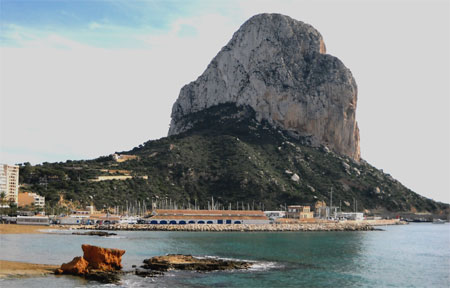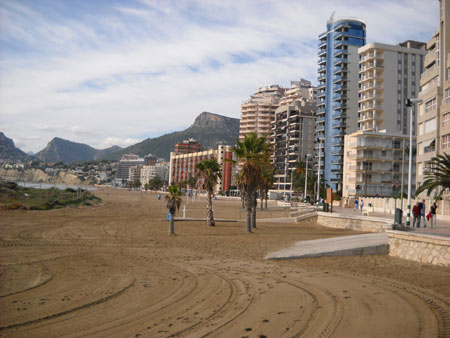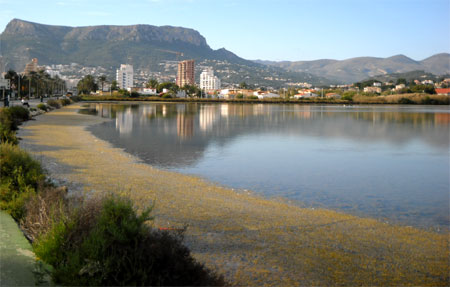Calpe (30,000 inhabitants) was a small town on the Costa Blanca until a few decades ago. Since then the municipality has experienced a huge building boom. About 15,000 Germans, Britons and other Northern Europeans have settled in the area. For example, there is a German club with several 100 members, a German carnival club and even a German-language weekly newspaper only for the Calpe region. In the summer several 100,000 thousand tourists come to Calpe. The place is characterized by the Penon de Ifach, a gigantic rock of 332 meters height beside the place. The mountain overlooks even the highest skyscrapers of Calpe by far. The Penon de Ifach is the landmark of the Costa Blanca. In the local language Valencian, the city is called Calp.

Discover affordable accommodation in Calpe now at Booking.com
Sights Calpe
There’s not too much to see in Calpe. The old town is worth a walk. It is situated about 2,5 km from the harbour on a hill. In the Museo Festero (Museum of Festivals) one gets an interesting insight into the culture of the Costa Blanca.
The main beach of Calpe is located southwest of the harbour. The beach itself is excellent, but the typical Spanish skyscrapers directly behind the beach are not exactly the most beautiful sight. Along the beach promenade there are many restaurants and bars that are especially well filled in summer. The prices in Calpe are generally rather cheap.
Between the harbour and the beach there is an archaeological excavation place, the Baños de la Reina (Baths of the Queen). Presumably it is an ancient late Roman fish factory.
Our tip: Ride the catamaran off the coast of Alicante. Short cruise (duration 2 hours) with drinks etc. for only 29 euros. Great experience, we liked it very much: >>> More informtion and booking

The port of Calpe is also interesting. In the fish hall (Lonja) there is still a fish auction almost every day in the late afternoon. Very popular are the fish taverns at the harbour of Calpe. Excellent fresh fish dishes are served here. Also the native Spaniards like to come here. On the other side of the rock there is also a large well-attended beach with some taverns and hotels.

Interesting is the big salt lake (Salinas) Saladar de Calpe in the middle of the city. The salt from the lake was an important source of income for Calpe in the Middle Ages. Today the Salinas is strictly protected. Especially the water birds make the lake interesting, especially the flamingos. Hobby birdwatchers with large camera lenses are often around the salt lake. Birds and nature are also worth seeing for walkers.
Hike to the Penon de Ifach: The rock can be climbed. It is perhaps the most popular hike on the Costa Blanca. In the summer the access must be even partly restricted due to the large request of hikers! The path starts in Calpe and is well signposted, an information centre explains the nature on and around the Penon de Ifach. The view from above is magnificent, sometimes one even sees up to the island Ibiza that is approximately 80 kilometres away.
More Questions and Answers about Calpe
Is Calpe beautiful?
Calpe is a coastal town on the east coast of Spain, in the province of Alicante. It’s a popular tourist destination known for its beautiful beaches, picturesque old town, and exceptional natural scenery. Many visitors consider Calpe a beautiful and entertaining place with plenty to do and see. However, beauty is subjective, and whether or not you find Calpe “beautiful” is a matter of personal taste and preference. Some are attracted to Calpe’s rugged coastline and spectacular rock formations, while others prefer the town’s charming narrow streets and historic buildings. The best way to find out if you find Calpe beautiful is to visit the town and see for yourself.
Which airport is in Calpe?
The nearest airport to Calpe is Alicante Elche Airport (ALC), located approximately 70 kilometers (43 miles) south of Calpe. It’s a busy airport with flights from many major European cities, including several destinations in Germany. From Alicante Elche Airport in Calpe, you can rent a car or use public transport.
Calpe, Spain: Any Hidden Gems?
Calpe is a popular tourist destination in Spain, known for its beautiful beaches, stunning scenery, and excellent restaurants. While it’s not a “secret” destination, there are many lesser-known sights and experiences that will make your visit to Calpe truly special. Here are some suggestions from Calpe, Spain.
Explore the Historic Center:
Calpe’s historic center is full of charming narrow streets, traditional houses, and quaint shops and cafes. It’s a great place to stroll around and soak up the local atmosphere.
Visit the Fish Market:
Calpe is a fishing village, and its fish market is one of the largest and most impressive in the region. Here you can watch local fishermen bringing in the day’s catch and buy fresh fish to cook yourself.
Excursions to Penon de Ifati:
The Penon de Ifaci, an imposing rock formation jutting into the sea, is one of Calpe’s most famous monuments. Hike to the top and enjoy breathtaking views of the town and coastline.
Enjoy the local cuisine:
Calpe is known for its excellent seafood and traditional Mediterranean cuisine. The town is home to many excellent restaurants offering local specialties such as paella, grilled sardines, and fresh fish dishes.
Relax on the beach:
Calpe has several beautiful beaches, including the long sandy beach of Arenal Bol and the secluded cove of Cala del Morello. Spend the day basking in the sun and swimming in the crystal-clear waters of the Mediterranean.
Does Calpe have a beautiful old town?
Yes, Calpe has a beautiful historic center, also known as “El Pueblo.” Calpe’s historic center is full of charm and character, retaining many original features from the days when Calpe was a small fishing village. Cobbled streets, whitewashed houses, and small squares with fountains and benches are typical of traditional Spanish architecture, creating an intimate and cozy atmosphere. The historic center is full of cozy restaurants, bars, cafes, and shops where you can buy local specialties and souvenirs. It’s an ideal place to explore this quiet and relaxing town, far from the beaches and hustle and bustle of modern Calpe.
Is Calpe good for shopping?
Calpe is a relatively small town and therefore doesn’t have as many shopping options as larger coastal towns. However, there are a few shops and boutiques, especially in Calpe’s historic center and along the promenade. Here you’ll find typical Spanish products such as jewelry, leather goods, ceramics, handicrafts, clothing, and accessories.
If you’re looking for a larger shopping center or department store, there are several shopping centers near Calpe, including La Marina Shopping Center in Benissa and Plaza Central Shopping Center in Benidorm. Both are just a short drive away and offer a wide selection of stores, including international brands and fashion chains. Overall, Calpe isn’t a town famous for its shopping experience, but there are some options for those who enjoy shopping.
Arrival Calpe
The narrow-gauge railway Trenet connects Calpe with the city of Denia and the tourist stronghold Benidorm. In Benidorm you can change trains for Alicante. Of course, there are also very frequent buses to all neighbouring towns, as well as to Valencia and Alicante.
Our tips: Good websites to prepare your holiday in Spain for the 2025 season |
| You are looking for a cheap hotel in Spain Booking.com: >>> Click here |
| We always book rental cars at Billiger-Mietwagen.de: >>> Click here |
| Best website for bus excursions, tickets Getyourguide: >>> Click here |
| Travel guides, maps, sunscreen … >>> Shop at Amazon |
| More travel guides: |